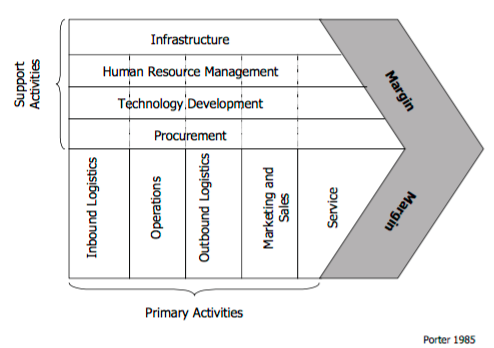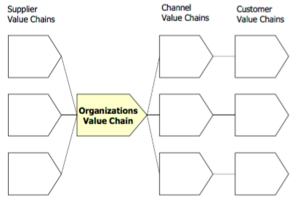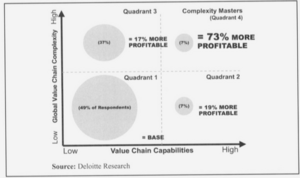Value Chain Analysis
The term ‘Value Chain’ was used by Michael Porter in his book "Competitive Advantage: Creating and Sustaining superior Performance" (1985). The value chain analysis describes the activities the organization performs and links them to the organizations competitive position. The goal of this analysis is to identify activities that are a source of cost or differentiation advantage and to identify those that could yield to the firms/projects competitive advantage, thereby helping to create products or services at a price which the customers are willing to pay for.
Contents |
The Concept
Value chain analysis describes the activities within and around an organization, and relates them to an analysis of the competitive strength of the organization. Therefore, it evaluates which value each particular activity adds to the organizations products or services. This idea was built upon the insight that an organization is more than a random compilation of machinery, equipment, people and money. Only if these things are arranged into systems and systematic activates it will become possible to produce something for which customers are willing to pay a price. Porter argues that the ability to perform particular activities and to manage the linkages between these activities is a source of competitive advantage. Porter distinguishes between two sets of activities. Activities that are directly associated with the creation or delivery of a product or service are termed primary activities and support activities are those that are linked to each primary activity that aims to improve its efficiency and effectiveness.
Primary Activities
- Inbound Logistics: all activities associated with the receiving, distributing and storing of incoming materials
- Operations: converting inputs (raw materials, energy and labor) into outputs (the final product/service)
- Outbound Logistics: all activities associated with the storage and movement of the final product to the end user
- Marketing and Sales: all activities involved in the assessment and encouragement of customers to purchase and the activities associated in providing a medium to purchase the product
- Service: activities related to the maintenance and enhancement of value to the end user after the product is sold
Secondary Activities
- Procurement: the acquisition of goods or services from an external source
- Human Resource Management: all activities associated with the management of people as per the requirements
- Technology Development: all activities related to the equipment, hardware, software, technical knowledge and procedures to transform the inputs into outputs
- Infrastructure: all other activities including legal, finance, accounting, public relations and quality assurance
Margin
The term 'Margin' implies that organizations realize a profit margin that depends on their ability to manage the linkages between all activities in the value chain. In other words, the organization is able to deliver a product / service for which the customer is willing to pay more than the sum of the costs of all activities in the value chain. The linkages are flows of information, goods and services, as well as systems and processes for adjusting activities. Their importance is best illustrated with some simple examples: Only if the Marketing & Sales function delivers sales forecasts for the next period to all other departments in time and in reliable accuracy, procurement will be able to order the necessary material for the correct date. And only if procurement does a good job and forwards order information to inbound logistics, only then operations will be able to schedule production in a way that guarantees the delivery of products in a timely and effective manner – as predetermined by marketing. In the result, the linkages are about seamless cooperation and information flow between the value chain activities.
Organisations Value Chain
In most industries, it is rather unusual that a single company performs all activities from product design, production of components, and final assembly to delivery to the final user by itself. Most often, organizations are elements of a value system or supply chain. Hence, value chain analysis should cover the whole value system in which the organization operates. Within the whole value system, there is only a certain value of profit margin available. This is the difference of the final price the customer pays and the sum of all costs incurred with the production and delivery of the product/service (e.g. raw material, energy etc.). It depends on the structure of the value system, how this margin spreads across the suppliers, producers, distributors, customers, and other elements of the value system. Each member of the system will use its market position and negotiating power to get a higher proportion of this margin. Nevertheless, members of a value system can cooperate to improve their efficiency and to reduce their costs in order to achieve a higher total margin to the benefit of all of them (e.g. by reducing stocks in a Just-In-Time system).
Industry Adoption
The evidence of improved financial performance of companies adopting value chain principles can be highlighted from a survey conducted by Deloitte, conducting research into international value chains.
The Deloitte survey (Deloitte, 2004) identified that companies, which could be classified as ‘value chain complexity masters’ (Deloitte, 2004), were distinctly more profitable that other companies surveyed, on average 73% more profitable. The analysis is based on 300 survey respondents, each with annual revenues of at least US$200 million. Value chain complexity masters were identified by value chain capability factors (product innovation, time to market, sourcing effectiveness, product quality, manufacturing flexibility, manufacturing productivity and cost effectiveness, customer service and supply chain cost structure) and value chain complexity factors (global dispersion of value chain functions – sourcing, manufacturing, engineering, and marketing & sales). The companies that had a high complexity and high capability they were classed as a complexity master’. Compared to other companies in the survey, complexity masters had developed superior capabilities in (Deloitte, 2004):
- Customer related operations - extensive investment in customer collaboration projects and customer relationship management.
- Product related operation - improvements in R&D through better process integration and investments in product data management systems and product lifecycle management systems.
- Supply chain operations - characterised by performance improvement initiatives such as quality management, quick change-over, lean manufacturing, and had also invest heavily in technologies such as advanced planning and scheduling software, warehouse management and transportation systems.
Although not published in the peer-reviewed academic literature, this research confirms that the value chain model is important in achieving competitive advantage. It demonstrates that where best practice is found, superior financial performance is also found.
Value Chain Analysis as a Project Management Tool
Using value chain analysis as a project management tool will help the project team to identify methods through which value can be added for both internal and external customers. It will further help to maximize this value created.
The tool can be used in a three-step process:
Analysis stage
Identification of activities to undertake in order to deliver the product or service.
The Activity Analysis stage requires the project team to brainstorm the activities necessary to undertake the project in order to add value, which eventually contributes to the end-user's experience. Therefore, this step requires an organized business process, which includes marketing, sales, order taking, operational process, delivery and support etc. that would help serve the customer needs. In other words, this stage requires the project team to carry out a systematic flow of work. Furthermore, it would also involve other factors such as:
- How does the project motivate the team to perform more effectively?
- How does recruitment takes place? Recruitment of effective individuals with the right skill would give best value.
- How to select and develop technologies and techniques?
- How to keep up-to-date with effective technologies and techniques?
- How to get feedback from customers on performance?
The activities are then listed in a simple flow chart, giving a good visual representation of the value chain.
Value Analysis stage
Maximizing the value of each activity in developing the product or service.
The Value Analysis stage involves the project team to list value factors for each of the activity identified in the first stage. Value factors are those that the customers would value when an activity is conducted and they vary with the nature of business. In order to maximize the value for each activity, the requirements of what has to be done or changed is put down besides each value factors.
Evaluating Changes and Planning of Action stage
Evaluation of changes and deciding whether the changes are worth making. The action plan is then followed to complete the project.
The final stage involves the project team evaluating the changes and plans for action. The team has to prioritize from the list of generated ideas that adds value to the customer and pick the quick and simple tasks to increase the team spirit, subsequently adhering to the remaining changes. The more difficult tasks are tackled in a systemic manner, providing a steady improvement.
Limitaions
Porter’s model for competitive analysis has generally found acceptance amongst both academics and industrial practitioners as a conceptual strategy model. However, it has been frequently described as being deficient for use in today’s environment (Hergert & Morris, 1989; Stabell & Fjeldstad, 1998). Dekker (2003) and Hines & Rich (1997) have both identified problems in the general approach of the value chain model:
- The exchange of sensitive information is difficult to manage;
- A fair division of the cost and benefits may be desirable, but how can this be objectively decided and what if this impact negatively on one of the partner firms;
- Participants fear that information abuse could be a big problem; and
- Lack of tools appropriate for creating visibility to enable any analysis to be undertaken.
Conclusion
Value chain analysis is an extremely useful management tool which identifies the activities that go into creating a superior product or service that is highly valued by customers. The outcome of creating this highly valued product is that customers are willing to pay a premium, which exceeds its costs thereby delivering higher profit. The usefulness of this model created by Michael Porter is mostly seen in its ability to breakdown work product into various activity groups to strategically focus the management on what are truly useful activities and what creates value. It also concentrates a company to determine a vision-a competitive advantage strategy- which will drive future products and services. Supporting activities are further validated in the process creating an understanding that these sometimes overlooked activities are integral to the value chain and value proposition for a company.


